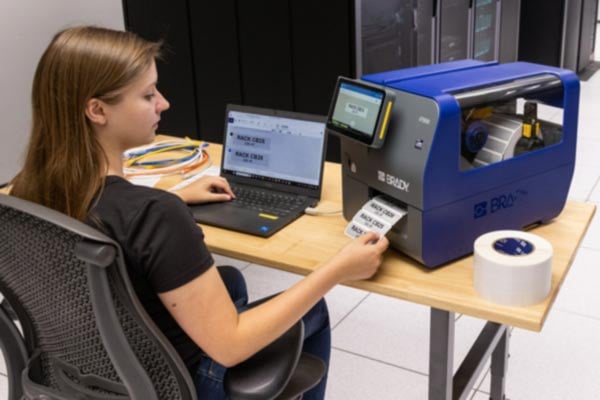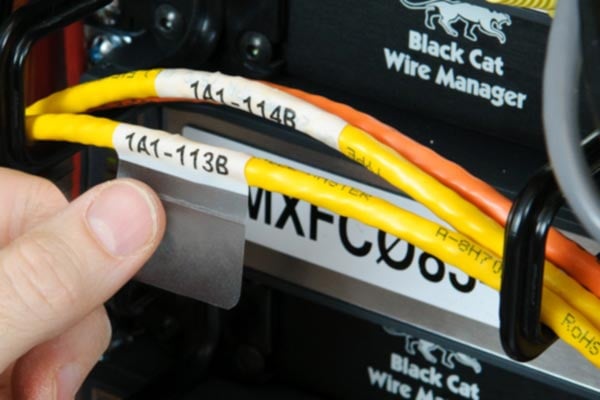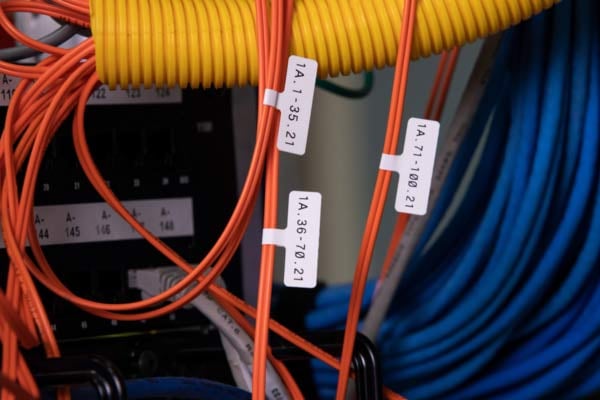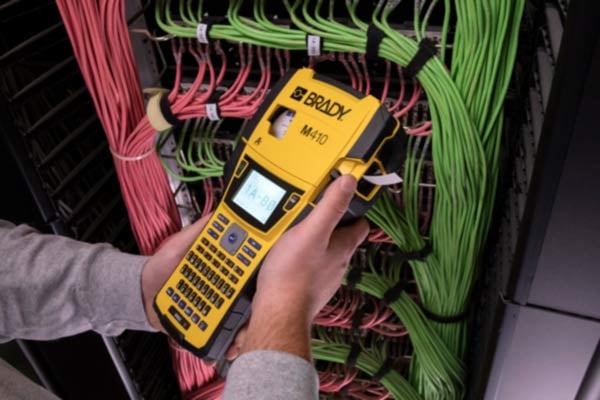How To Improve Data Center Uptime With Proper Identification
In today’s fast-paced digital world, downtime in data centers can cost businesses up to $9,000 per minute[1], according to industry estimates. As organizations increasingly rely on complex, multi-layered infrastructure to support their operations, the challenge of maintaining constant uptime has become even more critical.
One of the most effective ways to maintain uptime in data centers is proper identification. Whether it’s for cables, racks or equipment, Brady offers a comprehensive range of solutions to help streamline the labeling process. With the growing importance of data center tier classification, improving organization and operational efficiency not only prevents costly downtime, but also plays a role in achieving higher-tier ratings.
1. Forbes | The True Cost of Downtime.(opens in a new tab)
The High Cost of Downtime and Inefficiency
Data center downtime can have both significant financial and reputational consequences. Every minute of downtime could cost thousands of dollars, and severely damage customer trust.
Common causes of downtime
- Human error: One of the leading causes of downtime, human errors can range from simple mistakes, like accidentally unplugging the wrong server during maintenance, to more critical issues such as improper labeling of systems or incorrect data entry.
- Misidentification: When there’s a vast array of servers, cables and networking devices, confusion over which piece of equipment needs attention can lead to costly delays and errors. Without clear labeling or effective identification systems, technicians may waste valuable time searching for the correct equipment or mistakenly work on the wrong system.
- Slow response times: During critical incidents, time is of the essence. Slow response times can significantly extend downtime and exacerbate the impact on the data center's operations. When poor organization is at play, these delays are more likely to occur.
All these issues stem from a lack of clear identification: maintenance and repairs take longer, troubleshooting becomes more complicated and the risk of errors impacting data center uptime increases. And when resources are tied up in addressing these issues, it’s that much harder for a data center to grow and scale.
Worse yet, poor identification practices can hinder a data center’s ability to achieve a higher tier classification. Increased downtime and lack of redundancy directly affect a center's overall reliability and performance, which are key factors in tier evaluation.

Understanding Data Center Tiers and the Role of Identification
Data center tier classifications, as defined by the Uptime Institute(opens in a new tab), are a standardized way of measuring the resilience, redundancy and availability of a data center's infrastructure. The tiers range from Tier I to Tier IV, each representing a higher level of reliability and performance.
-
Tier I – Basic Capacity: Site-wide shutdowns are required for maintenance or repair work. Capacity or distribution failures will impact the site.
A Tier I data center can only protect its IT systems from utility outages, not human error. Any maintenance work will cause an interruption of service because infrastructure will need to be shut down.
-
Tier II – Redundant Capacity Components: Site-wide shutdowns for maintenance are still required. Capacity failures may impact the site. Distribution failures will impact the site.
Tier II data centers add redundant capacity components, but still allow a single distribution path. This allows for maintenance without impacting critical load, but unplanned events can still cause system-wide outages.
-
Tier III – Concurrently Maintainable: Each and every capacity component and distribution path in a site can be removed on a planned basis for maintenance or replacement without impacting operations. The site is still exposed to an equipment failure or operator error.
While Tier III data centers are still susceptible to human error and unplanned outages, they meet the standards of most organizations and can avoid downtime during maintenance.
-
Tier IV – Fault Tolerant: An individual equipment failure or distribution path interruption will not impact operations. A Fault Tolerant site is also Concurrently Maintainable.
Tier IV facilities are designed for mission-critical applications requiring maximum uptime, with annual downtime measured in minutes.
Factors that determine a data center's tier
There are several factors that can influence the classification of a data center’s tier, with redundancy, fault tolerance and uptime being the most critical.
- Redundancy: This refers to the backup systems and components in place to ensure operations continue in the event of a failure. A higher-tier data center will have more redundant systems, such as backup power supplies and cooling units, that automatically kick in if the primary systems fail.
- Fault Tolerance: Fault tolerance is the ability of a data center to continue operating even when one or more of its components fail. Higher-tier data centers incorporate advanced fault tolerance to minimize the risk of disruptions. For example, Tier IV data centers have multiple paths for power and cooling, which can continue operating even if one path fails.
- Uptime: Uptime is the percentage of time a data center is operational and available. Higher-tier data centers are designed for near-total uptime, with Tier IV facilities offering 99.99% availability, meaning only a few hours of downtime per year.
How proper identification leads to higher tier classification
Identification and organization play a pivotal role in meeting the requirements needed for a higher-tier classification. When data centers are well-organized, it leads to faster response times, reduced downtime and more efficient operations, all of which are key to achieving higher-tier status.
- Faster response times: When equipment and components are clearly labeled, maintenance teams can address issues much quicker. In Tier III and Tier IV data centers where uptime is critical, minimizing response time is essential.
- Maintenance best practices: Proper labeling and documentation ensure that redundant systems are understood and easily accessible. This also supports best practices for preventative maintenance, as operators can routinely check backup systems to ensure they’re functional without disrupting primary operations.
- Efficient asset tracking: Effective operations are fundamental for maintaining complex infrastructures. Tier III and Tier IV facilities — with their need for multiple paths and redundant components — require meticulous management of assets, cables and equipment. Structured organization ensures that everything is easily accessible during critical incidents.

The Power of Proper Identification
In environments where every second counts, understanding how to label cables in data centers with clear and accurate labels ensures that operations continue smoothly without unnecessary interruptions. By making it easier to locate and identify cables and components, teams can quickly respond to equipment failures, perform routine maintenance and troubleshoot network issues before they escalate into costly downtime.
Benefits of comprehensive identification
A robust labeling system has many advantages that support the efficiency, safety and reliability of a data center’s operations.
- Faster troubleshooting: It’s not uncommon for issues to arise unexpectedly. With effective labeling, technicians can immediately identify the problem and focus on the solution. This quick action positively impacts overall uptime, as problems are resolved faster and with fewer errors.
- Reduced risk of human error: Human error is one of the leading causes of downtime in data centers. Simple misidentification mistakes can result in extended downtime or even permanent damage. The more accurately and consistently equipment is identified, the less likely technicians are to make costly mistakes.
- Improved asset management: A comprehensive labeling system makes it easier to manage inventory and ensure that equipment is in good working condition. Additionally, when it comes time to scale operations, knowing the exact location and status of each asset facilitates more accurate decision-making.
- Enhanced organization: An organized data center is a more efficient data center. Clear labels create a sense of order, leading to fewer mistakes and greater overall productivity. When everything is labeled systematically, staff is able to focus on the task at hand.
- Streamlined maintenance and repairs: Routine maintenance and repairs can be significantly more efficient when equipment is properly identified. Technicians can quickly locate components that need attention, follow standard operating procedures and perform required checks without unnecessary delays.
- Improved safety: When dealing with high-voltage equipment or critical systems, technicians should be able to easily identify which systems are safe to touch or disconnect. A proper labeling system prevents confusion and reduces the risk of accidents.
Effective labels are durable and easy to read
Labels won’t be of much help if no one can read them. It’s essential that labels maintain legibility and durability over time, especially in data centers where labels are exposed to heat, cold, fluctuating humidity, airflow and other factors that can cause wear and tear. Labels that fade or fall off over time can result in costly mistakes. Durable labels made from high-quality materials and adhesives ensure that identification remains clear and accurate, regardless of environmental conditions. In the long term, investing in durable labeling systems will help preserve equipment and reduce issues that could lead to costly downtime.
Key Components of a Robust Data Center Identification System
Labeling ensures that every piece of equipment, cable and component is easy to identify. Include these elements in your labeling strategy to improve the overall efficiency and reliability of your data center.
- Rack and server labeling
Each server should be clearly marked with relevant identifiers such as server names, locations and functions. Rack labeling is equally important to help organize and locate servers in a dense rack environment.
- Cable and port identification
Cables are often bundled together in tight spaces, so clear and consistent identification is essential for troubleshooting and cable organization. Labels on cables and ports should include detailed information such as connection points, purpose and associated devices.
- Power and network infrastructure labeling
Power and network infrastructure are the backbone of any data center. Labeling various power supplies, backup systems and network devices ensures that these critical components are easily identifiable. Labels should indicate the type of connection, voltage ratings and failover systems in place.
- Asset tagging and tracking
By tagging servers, switches, routers and other equipment with unique identifiers, managers can track the status and maintenance history of each asset. This helps ensure that equipment is always properly maintained and upgraded when necessary.
- Location and zone identification
Data centers are often divided into multiple zones, each with different purposes. Proper identification means technicians can quickly identify the purpose of each zone. Labels make it clear where sensitive data is stored, where specific network equipment is housed and help prevent unauthorized access to certain areas or equipment.

Using the correct label in the correct environment
One of the most overlooked aspects of labeling strategy is using the correct type of label for the environment. Data centers experience a variety of environmental conditions, and labels must be able to withstand these conditions. In high-heat areas, choose heat-resistant labels to avoid peeling or fading. Curved surfaces may require flexible, durable labels that won’t lose their adhesion. Using the wrong label for the environment can lead to label failure, which can lead to a whole host of problems.
Standardized labeling for redundancy and higher-tier classification
Standardization plays a big role in meeting redundancy and organization requirements for achieving higher-tier classification. Tier I through Tier IV classifications, as defined by the Uptime Institute, require specific levels of redundancy and fault tolerance. Standardized labeling ensures consistency, making it easier to follow established protocols for redundancy. It also helps data centers maintain higher operational efficiency, which is needed to meet the standards of higher-tier classifications.
The importance of label printers
Intuitive label printers are essential for creating and printing labels on-demand. Printers should allow for quick adjustments to text, size and design, so technicians can print labels that meet specific needs. Additionally, label printers must be compatible with a variety of materials to ensure they can withstand different environmental conditions. A good label printer allows data centers to quickly respond to upgrades and repairs without experiencing delays or downtime.
Brady Solutions for Data Centers
Brady offers a range of innovative labeling solutions tailored to meet the unique needs of data centers. Whether you’re looking to enhance operational efficiency, minimize downtime or achieve a higher-tier classification, Brady has the tools and the expertise to set you up for success.

- Durable labels
Our materials scientists have engineered durable labels specifically for data center environments. Whether it's extreme temperatures or the wear and tear of everyday operations, our labels are designed to stick and stay stuck. Find a range of sizes and colors suited for cables and wires, server racks, floor and area marking, safety signage and equipment.
- Portable and benchtop label printers
Brady offers a variety of portable and benchtop printers, with automation options that save time and create efficiencies. Our portable printers are designed to provide flexibility so technicians can create and print labels right at the point of application. Find automation capabilities in our line of benchtop printers, like the Wraptor A5500-FO Wrap Printer Applicator, which features innovative ‘soft jaws’ to prevent damage to delicate fiber optic cables.
- Software solutions
It’s not uncommon for data centers to scale to accommodate growing demands. Brady’s software solutions are designed to streamline the continuous process of creating and managing labels. Create customized templates and import labels with Brady Workstation. Use Express Labels Mobile to print from your phone right on the spot, featuring BradyVoice™ which allows you to dictate data directly onto blank labels using your voice. Or use Brady Software Development Kit to seamlessly integrate your software with Brady printers, allowing for consistent labeling across the entire facility.
- Pre-printed labels
For data centers that require rapid implementation, pre-printed labels are a great solution. Brady’s pre-printed labels come in a variety of standard formats, including rack and server labels, cable tags and port identifiers. These labels are manufactured with the same high-performance materials and are designed for immediate use.
- Custom and color-coded labels
Have specific needs or looking for a specific color? Brady offers unlimited custom options in hundreds of different materials and colors. More and more, color-coded labels are being used in data centers to easily identify different types of equipment, cables or zones. Learn about pre-printed vs custom labels to help decide the best fit for your needs.
For data centers striving to achieve a higher-tier classification, Brady’s labeling solutions can help with maintaining clear and standardized identification systems. By reducing downtime and improving organization, we’re here to help data centers meet the strict redundancy, fault tolerance and availability requirements needed for Tier III and Tier IV certifications.
Tips for Labeling Success
Implementing a successful labeling system in a data center requires careful planning and attention to detail. Here are some things to keep in mind:
- Standardization and consistency are key: Ensure labels are easy to read and understand across the entire facility.
- Keep labels visible and accessible: When choosing label placement, consider using color to differentiate between types of equipment, zones or functions.
- Labels should be legible: Data formatting should be clear and concise, with all essential information included.
- Maintain accuracy: Regular audits and updates are essential to prevent errors over time.
Proper labeling practices not only improve organization, but also play a role in supporting a data center’s tier classification goals.
How Brady Can Help
Use this article as a guide to identify any areas of your data center that may need improvement. If you're looking to update your labeling practices, Brady offers specialized support and product demonstrations to help you find the right solutions for your data center. Tap into our resource center to learn more about our different material types, the benefits of creating a visual workplace, or find cost-saving calculators. You can also visit our virtual showroom to see our data center solutions in action.
As data center management continues to evolve, being proactive about identification strategies will not only help with navigating future challenges, but also ensure maximum uptime.
